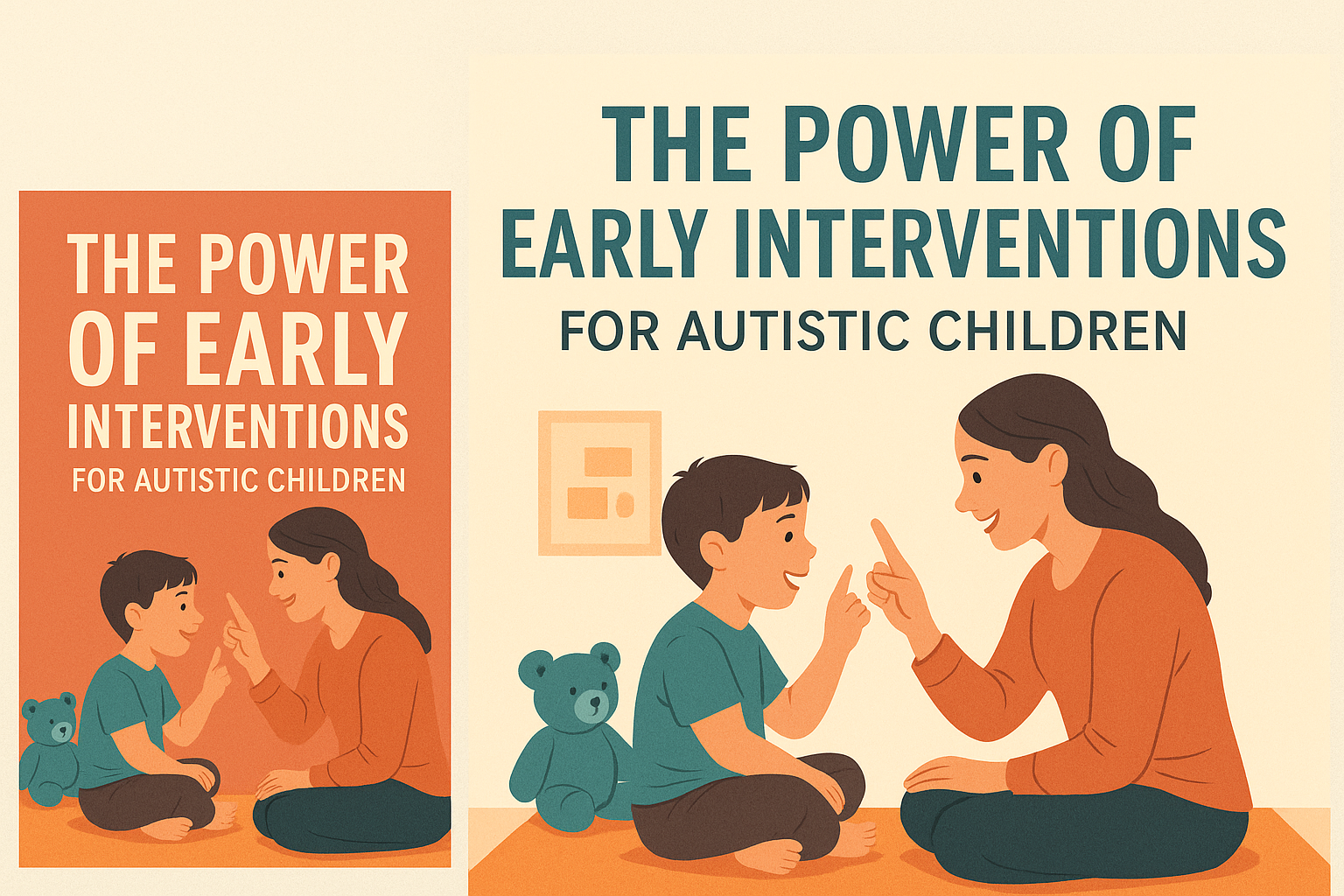HB Field
Nia Berrian •
August 20, 2025
The Power of Early Interventions
ASD Early Intervention
ABA Therapy

The Power of Early Interventions
Introduction
The Power of Early Intervention: Why Starting ABA Services Right After an Autism Diagnosis Matters and Leads to the Best Outcomes?
The first years of life (0–6) represent a critical window of brain development. During this period, the brain demonstrates remarkable plasticity, meaning it is especially capable of forming and strengthening new connections. Interventions introduced during these years are more likely to result in lasting improvements in communication, learning, and social functioning. Starting therapy early takes advantage of this “window of opportunity.” Studies show children who begin ABA before age 3—or earlier—make the most progress.
When a child is diagnosed with Autism Spectrum Disorder (ASD), parents often feel overwhelmed with questions about what to do next. One of the most important decisions a family faces is when to begin therapy. Research and decades of experience have shown that starting therapeutic services of Applied Behavior Analysis (ABA), Speech and Occupational Therapy as early as possible—ideally right after a diagnosis—can make a profound difference in a child’s growth, development, and long-term success. In this article, we will focus on early intervention with ABA Therapy, and understanding development of skills is not a linear process.
Early Intervention is Crucial and Matters the Most
Why Early Intervention is Critical?
The increasing prevalence rates in autism diagnoses during recent years has enhanced the establishment of a variety of interventions for young children with ASD. The scientific research consistently shows that beginning ABA therapy as early as possible—ideally right after diagnosis—leads to the most meaningful progress.
The early years of a child’s life are a critical period for learning. Between birth and age six, the brain is highly adaptable and capable of forming new connections at a remarkable pace. This means that skills introduced during this window—whether communication, social interaction, or daily living skills—are more easily learned and retained. For children with autism, early intervention can:
- Develop Language & Communication
Many children with autism struggle to express themselves. ABA therapy helps children learn to use words, gestures, or alternative communication methods so they can connect with family, teachers, and peers. It reduces frustration from not being able to communicate. - Encourage Social Development
Purposeful active engagement in playful activities promotes development of many social interaction skills such as sharing, turn-taking, waiting… Children gain the tools to build friendships and feel included. - Reduce Challenging Behaviors
Early ABA Therapy can teach positive alternatives to behaviors such as tantrums, aggression, or self-injury, making daily life smoother for the whole family. It reduces the frequency and severity of problem behaviors by teaching contextually appropriate functional alternatives. - Increase Independence
From dressing to eating, ABA therapy can teach everyday skills that allow children to become more confident and self-sufficient. Children who start ABA therapy early are more likely to transition successfully with stronger readiness in areas like attention, following directions, and social participation. They are more likely to require fewer therapeutic supports later in life.
In synthesis: Early ABA Therapy increases the likelihood that children will develop meaningful communication methods—whether through speech, sign language, or augmentative systems—and sets the stage for long-term quality of life for both children and their families.

Starting Sooner Leads to Better Outcomes
Multiple scientific studies have found that children who begin ABA therapy early show greater progress compared to those who start later. They are more likely to enter school more prepared to learn, adapt more easily to classroom routines, and may even require fewer support services as they grow older.
Delaying therapy, on the other hand, means missing out on valuable therapeutic time when children are most receptive to learning. Even a few months of waiting can make a difference in how quickly a child develops essential skills. Every month of delay means missed opportunities for growth. Because foundational skills such as imitation, play, and joint attention are easiest to learn at younger ages, waiting to start services often results in slower progress and more intensive needs later on.

Parents are Part of the ABA Team
Starting ABA therapy early doesn’t just help children—it also supports parents. ABA programs include parent training, where families learn strategies to support the child at home and in everyday life.
Working together with therapists gives the child the best chance for success, because having professional guidance early on can reduce stress and build confidence in parenting a child with autism.
Taking the First Step: Hearing the words “autism diagnosis” can feel overwhelming, but taking action quickly can set your child on a path to success. If your child has been diagnosed, reach out to an ABA provider right away to begin the process of assessment and therapy. The sooner your child starts, the sooner they can begin building the skills needed to thrive.
Conclusion & Key Takeaway
The evidence is clear: Starting ABA Therapy as soon as a child is diagnosed with autism gives them the best chance to learn, grow, and thrive. Early intervention is not just helpful—it’s life changing. Early intensive behavioral intervention maximizes brain development, builds essential communication and social skills, reduces challenging behaviors, and sets the foundation for long-term independence.
For parents, the message is simple but powerful: don’t wait. The earlier your child begins ABA, the greater their potential for growth, learning, and success.
References
- Lovaas, O.I. (1987). Behavioral treatment and normal educational and intellectual functioning in young autistic children. Journal of Consulting and Clinical Psychology, 55(1), 3–9.
- Daniolou, S., Pandis, N., & Znoj, H. (2022). The efficacy of early interventions for children with autism spectrum disorders: A systematic review and meta-analysis. Journal of Clinical Medicine, 11(17), 5100.
- Fuller, E. A., & Kaiser, A. P. (2020). The effects of early intervention on social communication outcomes for children with autism spectrum disorder: A meta-analysis. Journal of Autism and Developmental Disorders, 50(5), 1683–1700.
- Landa, R. J. (2018). Efficacy of early interventions for infants and young children with, and at risk for, autism spectrum disorders. International Review of Psychiatry, 30(1), 25–39.
- Maksimović, S., et al. (2023). Importance of early intervention in reducing autistic symptoms and speech–language deficits in children with autism spectrum disorder. Children, 10(1), 122.
- Dawson, G., et al. (2012). Early behavioral intervention is associated with normalized brain activity in young children with autism. Journal of the American Academy of Child & Adolescent Psychiatry, 51(11), 1150–1159.
- Reichow, B. (2012). Overview of meta-analyses on early intensive behavioral intervention for young children with autism spectrum disorders. Cochrane Database of Systematic Reviews.
- Smith, T., Groen, A.D., & Wynn, J.W. (2000). Randomized trial of intensive early intervention for children with pervasive developmental disorder. American Journal on Mental Retardation, 105(4), 269–285.
- Peters-Scheffer, N., et al. (2011). A meta-analytic study on the effectiveness of comprehensive ABA-based early intervention programs for children with autism spectrum disorders. Research in Autism Spectrum Disorders, 5(1), 60–69.
- Howlin, P., et al. (2009). Cognitive and language skills in adults with autism: A 40-year follow-up. Journal of Child Psychology and Psychiatry, 50(9), 1042–1050.
- Koegel, R.L., et al. (1996). Parent education for prevention and reduction of severe problem behaviors. Journal of Autism and Developmental Disorders, 26(6), 513–530.
The Power of Early Intervention for Autistic Children
By Nia Berrian, M.S; BCBA

